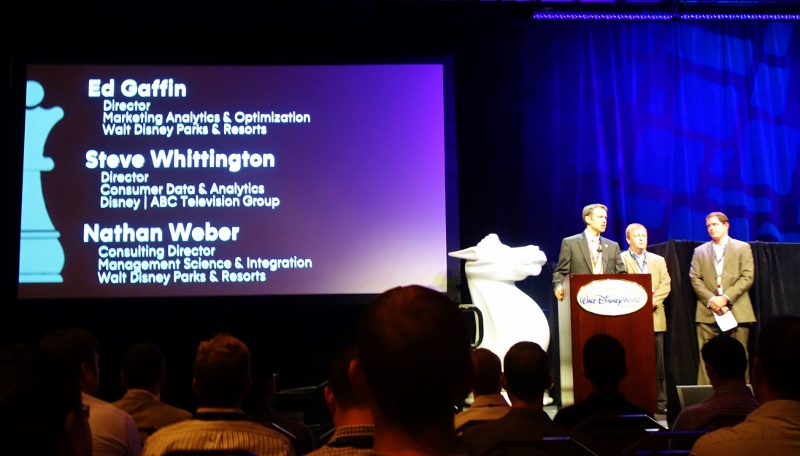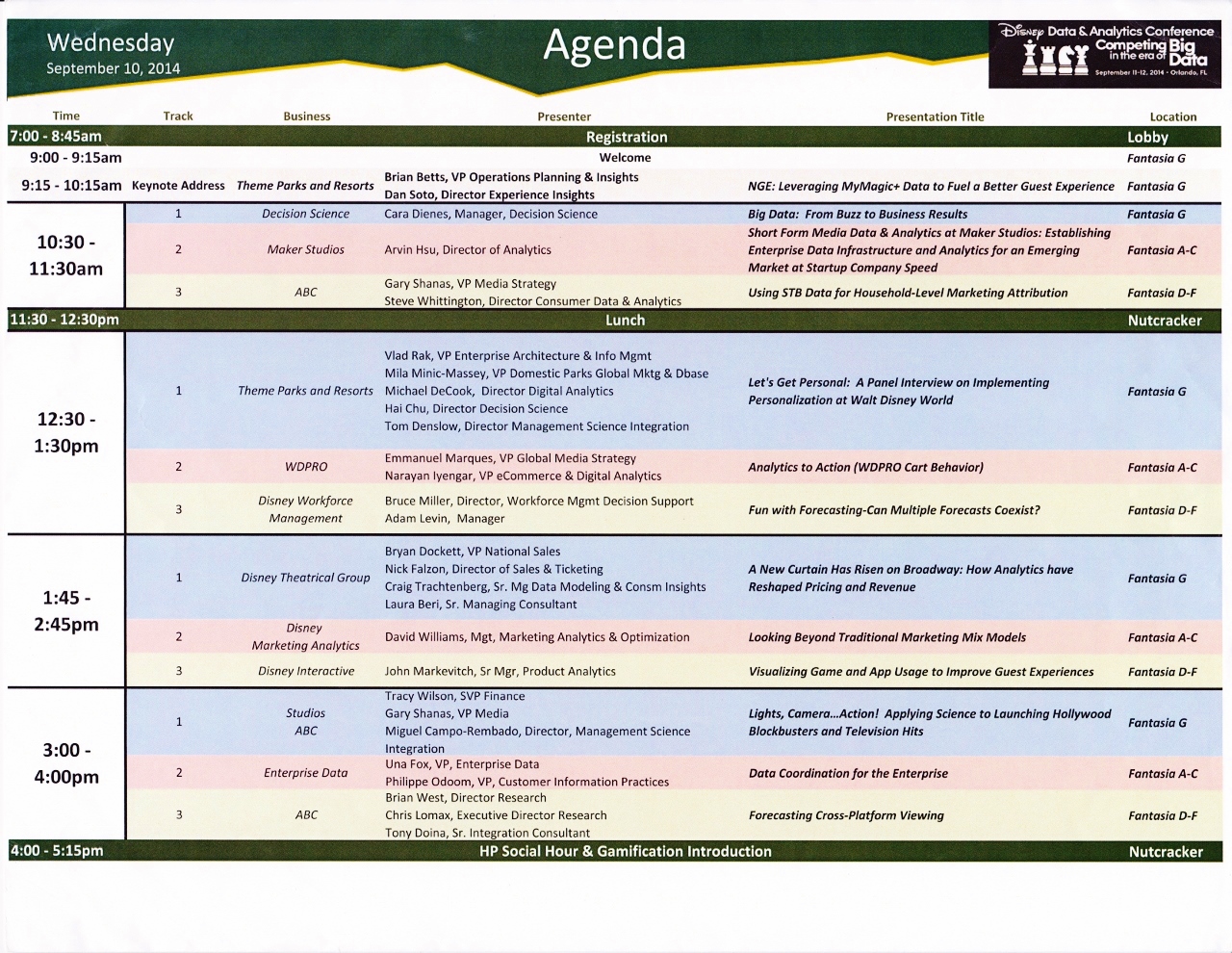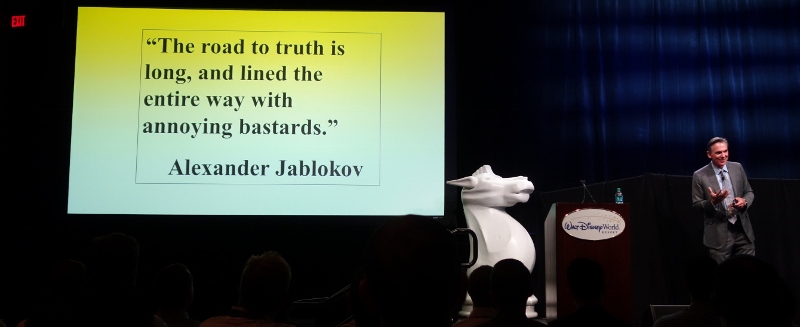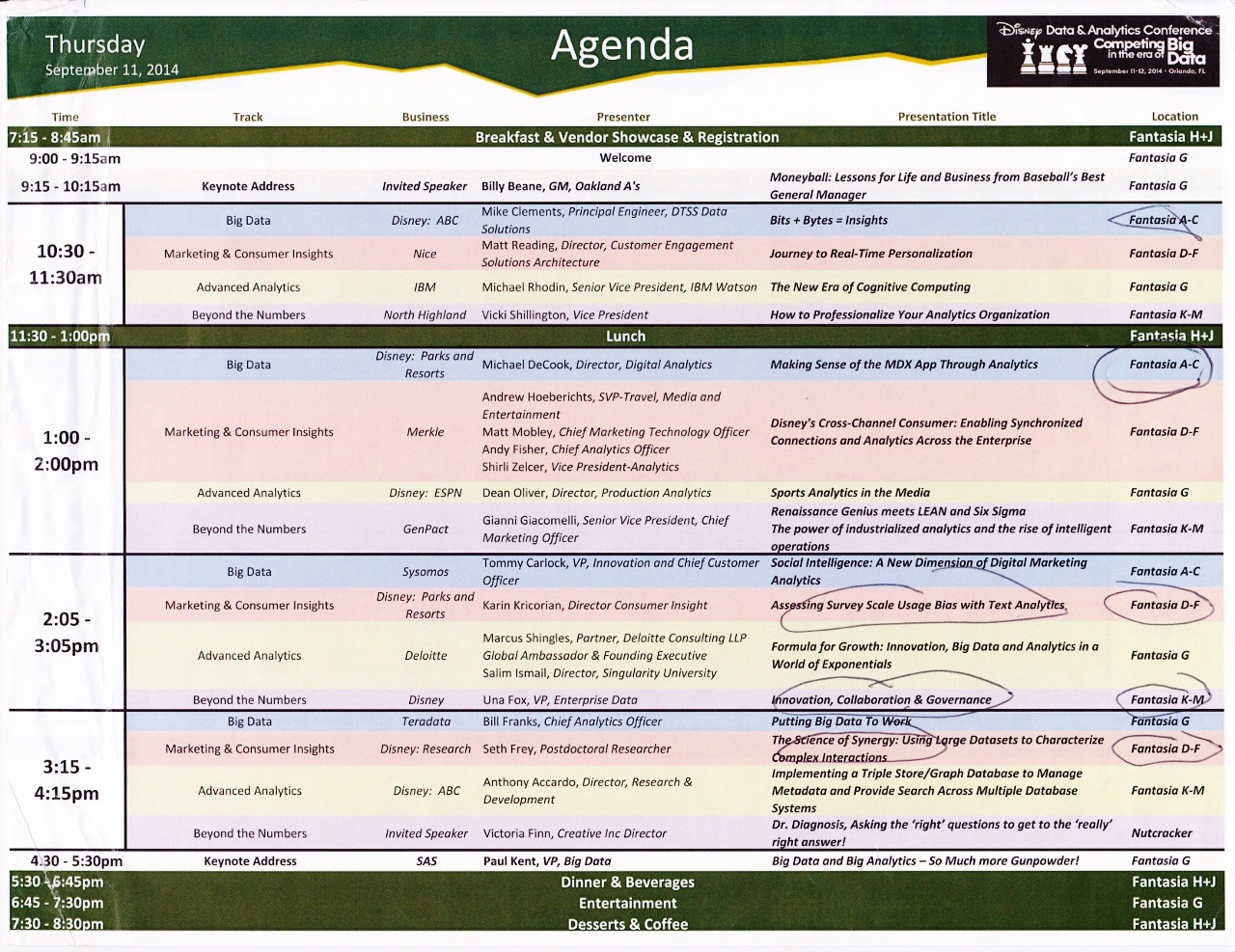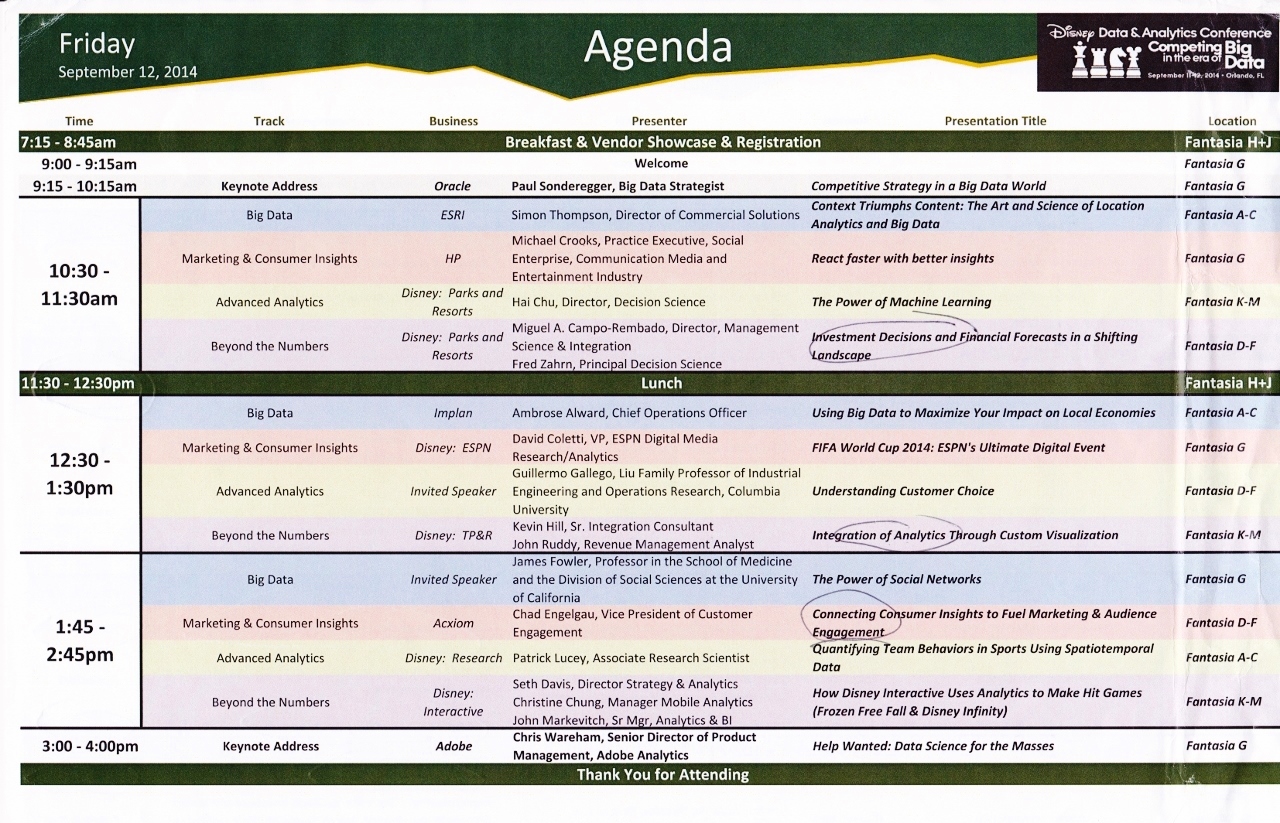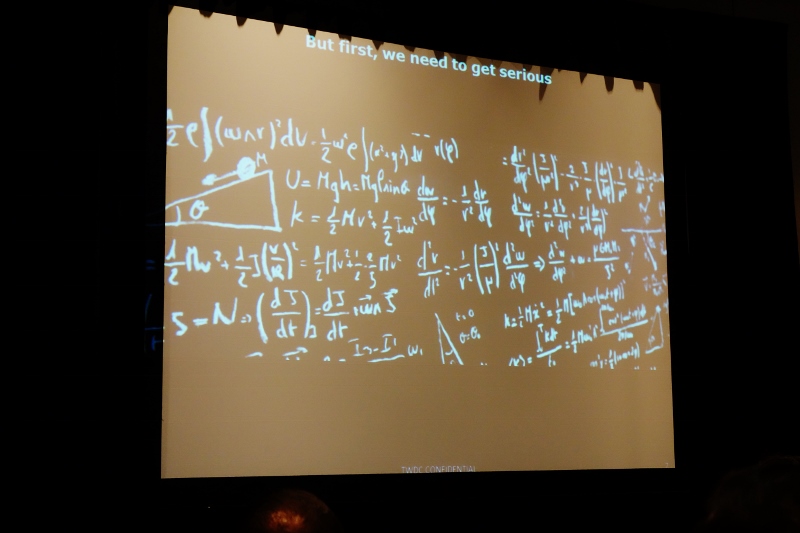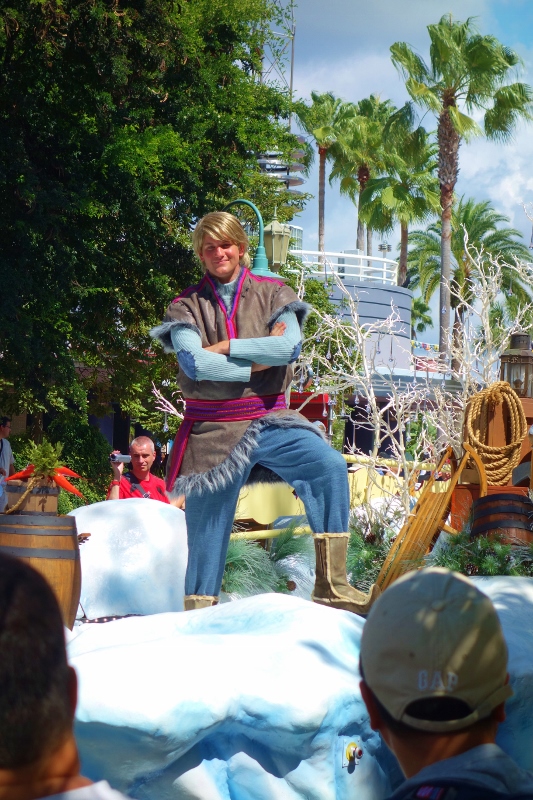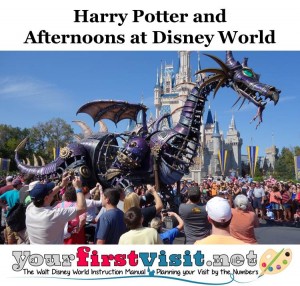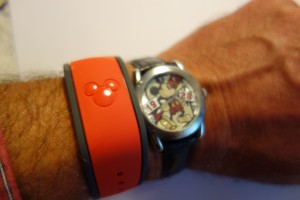Category — zz. Even Geekier than Usual
(Mis)understandings from the 2014 Disney Data and Analytics Conference
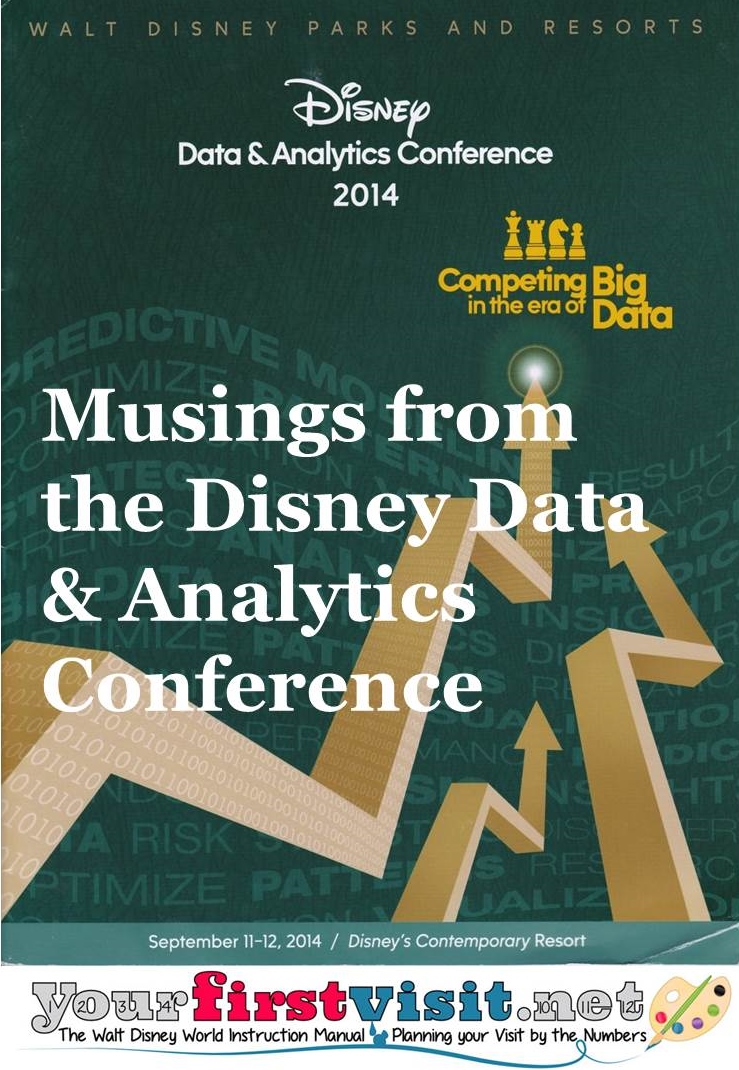
(It was canceled in 2013, perhaps because so many people who would have been involved in it were instead working to get FastPass+ back on track.)
While the conference is open to anyone willing to pay, the vast majority of attendees are Disney analytic folk and their software allies.
At the 2014 Conference in September, of the 800 or so attendees, more than 500 worked for one or another branch of Disney—particularly Parks and Resorts, but also units ranging from ESPN to the Disney Theatrical Group—the Broadway gang.
All are brought together to learn more about the use of data for business purposes, and the overwhelming attendance by Disney folk also means that you can try to infer what Disney is thinking about from the program offerings.
In 2014, the first day was Disney-only. Note some of the discussion topics (click to enlarge)–the keynote that began the day was “NGE: Leveraging MyMagic+ Data for a Better Guest Experience.” (“NGE”= “Next Generation Experience”–the overarching name of the program that includes “My Disney Experience,” FastPass+, MagicBands etc.) A later discussion was a panel on personalization. My thoughts on personalization, such as they are, in response to the 2012 Analytics meeting are here.
After that, the public sessions began—the Disney folk stayed, and were joined by data and analytics professionals from all kinds of businesses, by a number professors of management science—and by one consultant/blogger/guidebook author.
Billy Beane did the keynote that began the public session, and was wonderful. Depending on the audience member, his topic was either the use of under-appreciated data to gain a competitive edge, or about Brad Pitt, Angelina Jolie, and the filming of Moneyball, the book on the analytic efforts of the Oakland A’s. For either audience the talk was great–highly philosophical.
Then a number of breakouts and exhibit hall sessions were offered. New in the exhibit hall this year was booths staffed by Disney folk themselves—e.g. the team that builds the MagicBand near and far-field readers was there, as were some of Disney’s scientists from their Pittsburgh and other research operations.
The program from the first public day:
And from the second:
And some notes I took:
Ha! Not really…
But here are some things I thought I understood, learned or discovered over the course of the Summit:
During the course of a presentation of the analytics team behind the My Disney Experience app, one of the presenters commented that “the web page is for planning, and the app is for near-visit and in-park use.” This makes perfect sense, given the limitations of each—but I have never heard the distinction so succinctly put before. Frankly, the website is almost always easier to use, and sometimes more up to date, than the app—so it should be the first place you go for changes unless you are in the parks themselves.
Disney continues on a pathway to transform itself and use the data it is creating. One senior presenter noted that “I have frequent conversations with Bob Iger about how to create a more data-driven culture at Disney.” A much more junior analyst noted that “analytics is traditionally separate from operations, but we are seeing analytics being built into operations more.”
An example: there’s two types of MagicBand readers (or, strictly, RFID readers, since plastic tickets have RFID now too.) We are all familiar with the first kind, the ones you tap your bands on—to get into a room, to enter a park, for FastPass+ return, to buy stuff. These have limited range.
A different reader can read your MagicBand at a distance—I saw them in the exhibit hall and talked to their builders. It’s a black thingy that looks like a stereo speaker (like a small one if you are over 40, or like a large one if you are under 40). There’s more than 8oo of these distance readers at Disney World, and so far as I could tell from the conference, their promise is still largely untapped.
Take an example—Disney now can know exactly how many people are in Epcot at the beginning of IllumiNations, which of them are closer the bus stops and which are at the further end of World Showcase Lagoon, what hotels they are staying in, and which of them arrived at Epcot by bus. It can use this data to optimize the destinations of the waves of buses after IllumiNations to minimize total bus waits, but, so far, it seems in general not to be using data much this way.
(It’s using new data a bit. For example, the ability to tie a ride photo to a person comes from several of these far-field readers operating in tandem to geo-locate a MagicBand.)
Anyone who has consulted to or been a member of large organizations knows why. Operations are run by operators, not analysts, and new analytic approaches in the short run just create a burden on the operations team for their design, data gathering, testing, re-training and implementation. So almost everywhere “the way we’ve always done it around here” gets in the way of the optimal. A senior speaker noted “we create and store data on a bet that it will have value in the future,” and that future has not yet arrived.
So despite all the changes from FastPass+ in the last year, none of us has yet experienced a Disney World visit fully informed by data…this will come, but it will unfold in parts and pieces, over time.
By the way—the data Disney will use to work all this is not stored on your MagicBand.
Your MagicBand has two identifying systems, one for secure nearfield transactions using your pin, and the other for non-pin near and far-field transactions like entering the park.
MagicBands and their nearfield readers query each other to make sure they are communicating with authentic Disney devices, and then the only info grabbed by the system from your band is an alphanumeric code. The code is then pulled into Disney’s databases behind the scenes, and it’s those behind the scenes secure databases that have all your relevant data—for example, matching who you are to a valid park entry to a valid FastPass+ at that time, and then communicating back to the operating systems to make the FastPass+ reader turn green.
So while hacking of the behind the scenes databases is always possible, snatching your ID off your MagicBand is both hard (because of the validation handshakes) and also not even important, as all the bad guy will get is the alphanumeric identifier, not of much use without access to the secure behind the scenes databases.
But still, for this data to be useful Disney needs to know you are you.
Someone who has not been involved in creating a data warehouse would be astonished at the kinds of issues that emerge in them. The most profound of these is a single nomenclature—having a single and unique code that applies to a single and unique concept, and links all of the interactions of that concept within the system.
Take who you are. I have had many interactions with Disney over the years, using many variants of my name (“Dave Shute” to “David H. Shute” with other versions and typos in between), many credit cards, several different phone numbers, different email addresses, different physical addresses, etc. Plus, shockingly enough, there’s a lot of guys who have my exact same first and last name.
Now Disney has a better chance of improving my experience and lightening my wallet the more it knows about me—but it needs to know it is talking with me, despite whatever email, phone number, credit card, or intentional or unintentional name variant I am using!
The beauty (from a a data warehouse point of view…) of My Disney Experience and MagicBands is the much richer, more accurate, and more specific association of my identity with my touch points with Disney World—both in the planning process and at the resort.
It’s this much tighter linkage of identity and experience data that powers the whole potentiality of the NextGen project—not FastPass+, which is simply the hook that makes us willing to allow Disney to capture this connection of identity and experience.
Identity raises fascinating issues in other contexts as well. Most profound among them is the misleadingly simple question of “what is the product?”
Take a simple example. Under traditional management approaches, “Frozen” is the overarching brand, which then has sub-brands of all the characters in it, some of which cross to other brands—e.g. Anna and Elsa work both separately and as a pair of sisters, and work both as Frozen characters and as part of universe of “Disney Princesses.”
But say you had dolls for all the major characters for single unit sales, and wanted to know how to optimally group them for package sales. You could guess based on rules of thumb, heuristics, and standard literary analysis.
Or you could use data. With enough sales, purchaser identity data, and analysis, you could identify which subgroups of characters are bought by the same family—e.g. just as a made-up example, you might discover that Elsa is often bought alone, but rarely Anna alone—that Anna is sold most often with Elsa, or with Kristoff, yet all three are rarely bought together.
This analysis begins to accurately define the higher order groupings of the components of the offering which otherwise would take mind-reading, some of which will be obvious but some of which are likely to be novel. That is, it helps identify and define the actual products as customers see them in their own minds…
Take this analogy to the parks. We think of there being parks, and within them lands, and within them attractions. We know that in general some attractions are more attractive to definable demographic groups than others—especially by age. But everything is much more subtle and various than that. With the data becoming increasingly available to Disney—plus some guest surveys—all of the different ways that the parks are experienced, and how pleasing they are, can be used to more sharply understand—and manage to– all the different “products” actually offered.
But first Disney needs to start using much more the data it’s already collecting from the far-field readers!!
Follow yourfirstvisit.net on Facebook or Google+ or Twitter or Pinterest!!
October 23, 2014 22 Comments
Harry Potter and the Battle of the Afternoons
Sometime this summer—my bet is June 13, by the way, technically spring—On July 8th the second installment of Harry Potter at Universal Orlando will open at Universal Studios. The effect for Harry Potter fans will be to make Universal a two-day park.
For Disney World this has multiple implications, and its responses will likely try to address then all. The core issues for Disney are
- Harry Potter will draw incrementally more people to Orlando, so Disney’s task for these is to grab some of their time and money while they are in town
- Of the people who would have come to Orlando anyway, Disney’s task is to not lose too much from people spending time and money at Universal that they might otherwise have spent at Disney World
In this post, I’m gonna focus on the second issue, as it is widely misunderstood—and in particular the role of FastPass+ in it.
The best way to see the new and older Harry Potter is to get a two-day multi-park ticket, stay in a Universal hotel, and use Universal’s early entry to hit one area each morning, fitting Hogwarts Express rides back and forth in as well.
For younger kids, though, there’s not enough age-appropriate stuff to stay all day at Universal—and that’s where FastPass+ kick in.
In the olden days, the best way to see Disney World was to arrive before open, see a bunch of rides first thing, and then pull old-style FastPass+ over the rest of the day. Guests who arrived in the afternoon—e.g. after a visit to Universal—would see long lines stand-by lines and Fastpasses either gone or with very late return times. Nobody with Disney World experience would advise that such could be a great day.
But with FastPass+, you can book three great Disney World rides for the late afternoon/early evening and be able to see them with hardly any wait. So a day that begins at Universal and ends at Disney World can be a much better experience—one that would be recommended, rather than suggested as to be avoided.
This is the key point. With great late days available at Disney World, the competition is no longer about which park gets the only entry that day—competition is about how to spend the afternoon and evening. That’s a much easier competition for Disney to win with pre-teens and their families.
Note that Disney’s recent deals have had a lot of “buy this many nights and tickets, and get another ticket day free.” It’s been years since Disney World has had free tickets for so many deals—and the effect of these is to make another afternoon/evening at Disney World that much more doable.
And you can also see other stuff happening in late August and September that has the effect of making Disney World more attractive in the afternoons and evenings—one that’s clear, one that’s speculative, and one that’s probably me just making stuff up.
- The clear one: Food and Wine is beginning a week earlier in 2014 than in prior years—adding that much more attractiveness to Epcot in the afternoons and evenings that week.
- The speculative one: The Magic Kingdom has more and earlier 7p closes in September than in past years. The widespread guess is that this means that Mickey’s Not-So-Scary Halloween Party will have more and earlier shows in 2014 than in the past—e.g. an earlier show may be September 1. Later in the month, there’s likely to be two more shows than in recent years. Add it up, and Magic Kingdom becomes more attractive in the evenings. (Confirmed.)
- The made-up one: Disney’s Hollywood Studios has four straight nights in early September (the second through the fifth) with no Fantasmic scheduled. It’s been years since the last time that happened. Sensible people are guessing that this is because of a quick rehab to the Fantasmic operations. But I can’t help wondering if there might not be some special event planned those evenings to make HS more attractive those nights…perhaps a test of a villains party?
I’m probably wrong—as usual—on that last guess. But more broadly, Harry Potter is gonna happen, and it’s gonna have a real draw for some subsets of people who would otherwise attend Disney World. FastPass+–and some of the other items I’ve noted—make afternoons and evenings at Disney World much more attractive than they’d otherwise be, making its parks more competitive for the second half of a visitor’s day…
Follow yourfirstvisit.net on Facebook or Google+ or Twitter or Pinterest!!
April 3, 2014 14 Comments
More and Less Crowded Days at Disney World Parks
PICKING THE BEST AND WORST DAYS TO VISIT THE DISNEY WORLD PARKS
As I’ve noted extensively elsewhere, this time of year–basically, until December 20, excluding Thanksgiving Week–although Disney World is largely un-crowded, you can choose your way into a really crowded park.
The issue is varying evening hours and entertainment, which can draw, or repel, huge numbers of people.
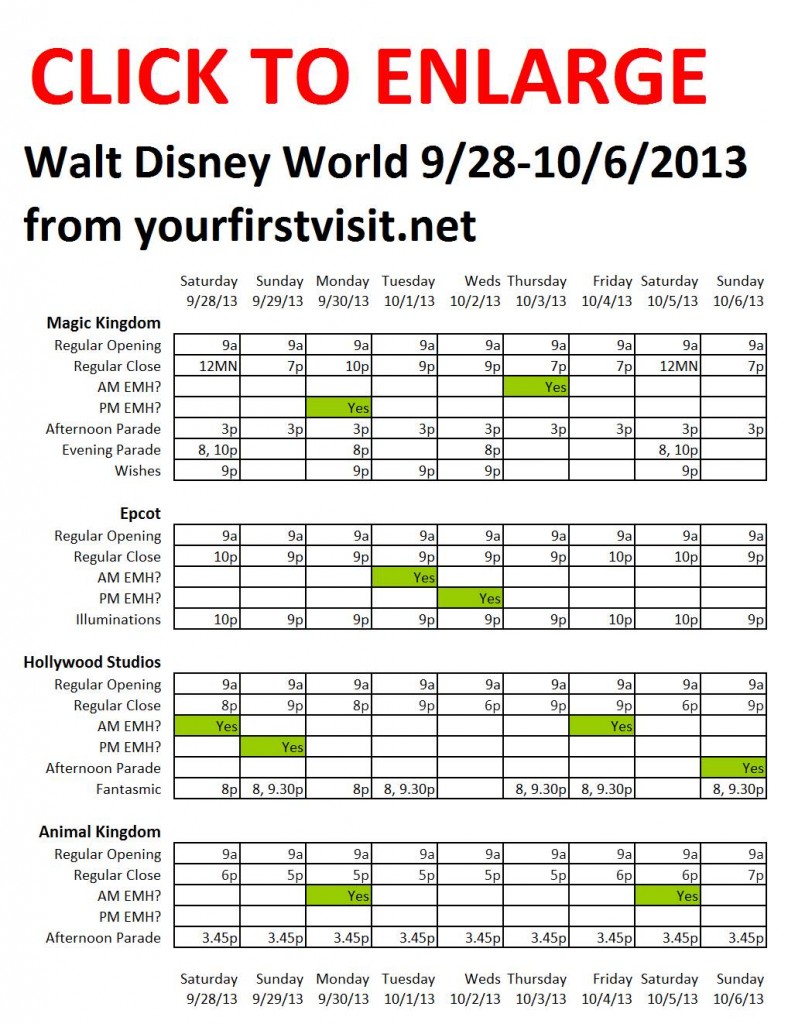
- Two early 6p closes at Disney’s Hollywood Studios (10/2 and 10/5), each with no Fantasmic
- Four early 7p closes at the Magic Kingdom (9/29, 10/3, 10/4, and 10/6), each with no Wishes or evening parade, because of Mickey’s Not-So-Scary Halloween Party and
- Late 10p closes at Epcot Friday and Saturday, because of the Food and Wine Festival
Here’s the basics: people are repelled by early closes and the absence of well-loved evening shows, and attracted by late closes and the traditional evening entertainment.
So look at Saturday 10/5 at the Magic Kingdom–it’s the only day in a four day stretch where the park is open later than 7p, and when Wishes and the evening parade will be showing. Moreover, Disney’s Hollywood Studios closes quite early, and people will avoid that park and be particularly drawn to MK for the same reasons.
So the Magic Kingdom will be just mobbed the 5th.
At Disney’s Hollywood Studios, the 3rd and 4th, with normal closes and normal evening entertainment, are between two days with 6p closes and no evening shows. Both dates will be much more crowded than the early-close 2nd and 5th.
The 4th will be particularly crowded at the Studios. On the 4th, it has morning Extra Magic Hours, which always draws extra people from the Disney resort hotels–and those without park hoppers then stay all day. Moreover, there’s nothing going on at other parks other than Epcot’s later 10p close to draw people away from it. And the Magic Kingdom’s 7p close will have people looking away from the Magic Kingdom for the next best alternative…
So the takeaway? If you can see the evening shows on a different night, then make your principal park visits on days with they have materially early closings.
You will find easy lines and un-crowded parks, and see more than you would on days with longer hours–because those longer hours attract disproportionate crowds!
September 30, 2013 No Comments
Walt Disney World Crowds in 2014: What’s Up, and What’s New
PREDICTIONS ABOUT DISNEY WORLD CROWD IN 2014
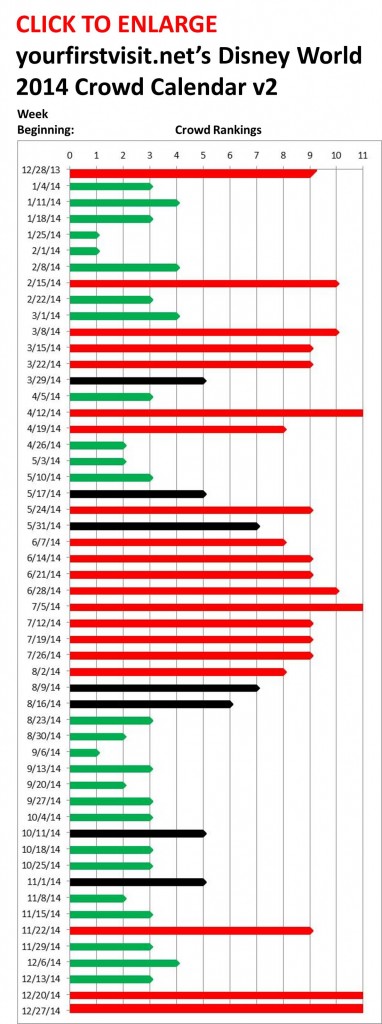
I published a revision of the 2014 crowd calendar earlier this summer—the last revision needed, barring typos or unanticipated events—after the full set of public school calendars I analyze (about 180 this year) became available.
The 2014 calendar revision includes both some changes in approach and in specific week rankings—though only a couple of weeks changed crowd class–e.g. from “green” (lower waits) to “black” (moderate waits)–or week class, e.g. from “recommended” to “not recommended.”
The purpose of my Disney World crowd calendar is to indicate (especially for first-time visitors who may never return, but the math is true for everybody) better weeks, which are marked in green; not so good weeks, marked in black; and bad weeks, marked in red.
Because my recommended itineraries are 9 days and 8 nights, “weeks” as I define them begin on Saturdays and end 9 days later on a Sunday. That is, they include two weekends and the weekdays between. I’m not like other people, but I am consistent to myself…
Each week gets a crowd rating, from 1 to 11, where 1 is lowest crowds. In a bold step, for the 2014 crowd calendar I added “4” and “8.” There’s a long story behind that, which I’ll skip so that I keep my one remaining reader.
These ratings are ordinal, not cardinal. A week rated “9” is not three times worse than one rated “3”—but it should be better than a week rated 10, and worse than one rated 8.
Ok, with all that preamble out of the way, here’s some comments on 2014 crowds at Walt Disney World, focused on weeks that got revised but also including some general observations on each month.
DISNEY WORLD CROWDS IN 2014: NOTES AND CHANGES
January 2014
New Years crowds are driven by school holidays, which are profoundly affected by the day of New Years. A midweek New Years means many kids are off that whole January week, with massive crowds continuing through the Saturday after New Years. That’s what we see in 2014, with crowds extending to Saturday January 4th.
The rest of January tends to be low-crowd, with exceptions over the Marathon Weekend and Martin Luther King Weekend. The week beginning January 11 has the Marathon at one end and MLK weekend at the other (though with great days in between), so I bumped its overall rating from 3 to 4 to reflect the weekend effects.
February 2014
Crowds are high in February beginning the Thursday before Presidents Day through the Saturday after.
Most kids get just a three day weekend here, but a ton of kids in the snowier New England states have the whole week of President’s Day off—and other kids are taken out of school. So crowds this week are massive.
Other kids get a longer weekend beginning Thursday or Friday at the end of the week before Presidents Day, and Disney also has a dance competition that begins late that week, and another running event—the Princess Half-Marathon– at the end of the week of President’s Day.
To reflect the impact of earlier-beginning long weekend holidays and the dance competition, I changed the week rating of the week beginning 2/11 from 3 to 4. This week will be fine until Thursday, but then crowds will build.
The week beginning 2/22/14 had its rating changed from 2 to 3, to reflect the weekend crowds at the beginning of the week from President’s Day and hangover effects from the running events the weekend of the 22nd.
The rest of February is great from a crowd point of view.
March 2014
March and April are the hardest times to forecast. Crowds are affected by the date of Easter, traditional school break dates in districts that don’t tie their spring breaks to Easter, and the need of northeasterners to get away from the snow. I can quantify the impact of spring break dates, but not so well the ebb and flow of those escaping the snow.
Unless Easter is very early, typically the first week of March is fine—and I’m forecasting it as such in 2014. However, I’m a little worried about the impact of visitors from the massive HIMSS conference (which ends 2/27) and for that reason have bumped the crowd rating for the week beginning 3/1 from 3 to 4.
The rest of March looks pretty bad to me…
April 2014
In my draft 2014 crowd calendar, I had thought that the week beginning March 29 would be pretty good, but the school calendar analysis showed more kids on break that week than I had expected. (I’ve figured out how to get this closer for 2015.) So I’ve changed my crowd rating of this week from 3 to 5, moving it from the “low” to the “moderate” class. It may be worse—but in my dataset, 80% of districts with this week off also have another major spring break.
The week that begins two weeks before Easter typically has few US kids on break (many UK kids are off then, but not enough to profoundly affect crowds), and this is true for 2014 as well. The week before Easter is always the worst week for kid’s breaks—and will be so in 2014 as well. The week after Easter is never good, but it is better in years–like 2014–with a very late Easter. Based on actual break schedules, I’ve lowered the crowd rating for the week after Easter from 9 to 8—still bad, but not as bad as some years.
Late April crowds beginning seven days after Easter are just fine!
May 2014
Early May crowds are fine. Later May sees a build in crowds, peaking the week that includes Memorial Day, partly because of a trend towards earlier ends to summer breaks—which leads to earlier beginnings to these breaks, and more kids out of school in late May and early June.
Star Wars Weekends clot Disney’s Hollywood Studios Friday-Sundays in later May and early June.
June 2014
Early June crowds have been worse than forecast both of the past two years, and schools are out even earlier in 2014. As a result, I’ve changed the rating for the week beginning 6/7 from 7 (Moderate-plus) to 8 (high minus). Later June sees even higher crowds.
July 2014
Some kids don’t get out of school til the end of June, and others go back in early August. But pretty much all kids are out in July, so it’s the worst month for crowding at Disney World (some holiday weeks the rest of the year are worse than any single July week, but overall, July is the worst month).
There may be fewer tourists from South America during their July 2014 winter break because of the FIFA world championships in Brazil absorbing some vacation time and budget. But I’m not expecting to see this affect July crowding much—though, as we’ll see, it may have an effect in September.
August 2014
August crowds seem to have been getting a little better, likely for the same reason that early June is getting a little worse—the trend towards earlier returns to school.
As a result, I’ve dropped the crowd ratings in each of the first three weeks of August 2014, from 9 to 8 the week beginning 8/2, 9 to 7 the week beginning 8/9, and 7 to 6 the week beginning 8/16. However, all three weeks remain firmly in the “avoid” or “not recommended” categories…
Later August is just fine from a crowd point of view.
September 2014
September is typically the lowest crowd month at Disney World. All US kids are back in school by early in the month, and parents resist taking their kids out of school at the beginning of terms (that’s why later January and early February are almost as uncrowded).
I have, however, bumped the ratings up for the week of 9/13, which went from 1—lowest crowds to 3—low crowds.
There’s two issues I see this week, which is typically spring break for South American kids (though many families take their kids out of school the week before as well, which I’ve bumped from 1 to 2).
One is that some South American families who missed their traditional July visit because of FIFA will come in September instead. Second is that the next part of Harry Potter will have opened at Universal by now, creating an even stronger than normal draw to Orlando for South American spring breakers.
I’m still classing these weeks as low—just not as low as in prior years. Note that beginning in early September and going through most of the rest of the year, which day you go to the Magic Kingdom really matters.
October 2014
Other than the week that includes Columbus Day (the week beginning 10/11 in 2014) October is a great month for avoiding crowds at Walt Disney World. Worries some express about the impact of fall breaks on Disney World crowds are overblown. I made no changes between the draft and final ratings in October.
November 2014
November has two problematic weeks—Thanksgiving week, and the first full week of the month, Jersey Week.
Jersey Week is not bad, but is worse than the weeks before and after it. Thanksgiving week is bad.
The month’s crowd ratings did not change.
December 2014
You won’t find a sound guidebook or website that does not trumpet the period between the Sunday after Thanksgiving and the middle of December as a wonderful time to visit. The three weeks here are always my top three ranked weeks of the year for Walt Disney World visits, and are so again in 2014.
Well, people read this stuff and make decisions based on it, and every year these three weeks get a little more crowded.
So for 2014 I’ve increased the crowd rating of each of these three weeks—the week beginning 11/29 from 2 to 3, the week beginning 12/6 (Pop Warner Week) from 3 to 4, and the week beginning 12/13 from 2 to 3. These are still classed as “low crowd” weeks—just not as low crowd as they were just a few short years ago.
I worry sometimes that this is my fault…my “Weeks to Visit Ranked in Order” pages have been seen more than 2.5 million times…but then I decide that I’m just not that important.
Later December—the weeks that include Christmas and New Years—is always a mess, and the mid-week holidays in 2014 mean that all of the weeks beginning 12/20 and 12/27/2014 will be horrible in 2014 as well. My crowd calendar goes to 11 just for these weeks…
MORE ON WHEN TO GO TO WALT DISNEY WORLD
- For when to go to Walt Disney World, see this
- For the next best dates, see this
- For the best and worst times to visit, see this
- For 2013 weeks to visit, ranked in order, see this
- For the 2013 Week Picker, click here
- For 2014 weeks to visit, ranked in order, see this
- For forecasting crowds at Walt Disney World, see this
- For the 2013 Crowd Calendar, click here
- For the 2014 Crowd Calendar, click here
- For seasonal pricing at Walt Disney World, see this
- For 2013 price seasons, click here
- For 2014 price seasons, see this
- For weather at Walt Disney World, see this
September 16, 2013 9 Comments
More Detail on Disney World’s MagicBands
“MagicBands” are Walt Disney World wristbands that take the place of Disney World hotel rooms keys, park tickets, and–for now–Fastpass+.
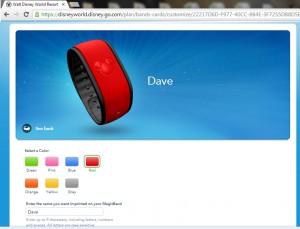
(See this and its links for more on MagicBands and Fastpass+.)
In this post, I’m just detailing–memorializing for history??–the ordering and delivery process.
ORDERING AND CUSTOMIZING YOUR DISNEY WORLD MAGICBAND
To order a MagicBand, you have to be in the test. See the link above to see how you find out if you are in.
If you are in, then you can customize your MagicBand on MyDisneyExperience.com once you’ve logged in.
There’s multiple color options you can choose from among–you can pick the same color for everyone in your group, or mix and match. See the image at the top of the page for the colors available.
In addition, you can add text that will show on the inside of the Magic Band–both fun, and handy if your kids (or husband) all want the same color.

GETTING YOUR MAGICBAND FOR WALT DISNEY WORLD



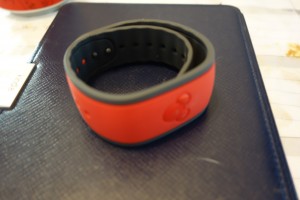
I’ll be using it–and my Fastpass+–in later September: the 20th at the Magic Kingdom, 21st at Hollywood Studios, and 22nd at Epcot.
So since I’ll probably be posting and tweeting about the MagicBand and my overall experience with Fastpass+ (which I haven’t had a chance to test til now), you should probably…
September 8, 2013 50 Comments
Disney World Crowds in 2014: Summer Crowds
DISNEY WORLD 2014 SUMMER CROWDS: THE PRINCIPLES
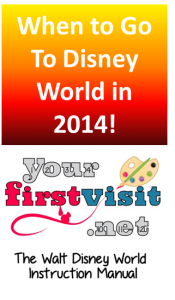
- Public school summer break calendars, which have start and end dates more varied than you’d think
- The beginning of the peak of the hurricane season, in later August
Pretty much all kids are off all of July. As a result, July is the busiest summer month, and during it, the weeks shaped by 4th of July travel the busiest week.
Later July is also the traditional South American winter break.
However, in 2014 the FIFA championships in Brazil June 12 to July 13 may absorb many soccer-mad South American fans’ vacation budgets, leading to a little less Disney World visitation in the winter break. I haven’t adjusted my crowd calendars for this, as the parks will still be plenty mobbed! But later July might be a bit better than forecast.
Varied dates for when summer breaks begin means June can start well but then build quickly to high crowd levels.
August has the opposite pattern, beginning with high crowds, but, through the combination of a trickle turning to a flood of back-to-school dates, and savvy travelers avoiding the peak of the hurricane season, it ends quite un-crowded.
Summer school calendars have been evolving to earlier August starts and as a result earlier June releases. This has made early June less good, and mid-late August, better, than in prior years. My 2014 forecasts reflect this.
Families that can only visit in the summer (for example, school teachers) should go as early in June or as late in August as their schedules permit. [Read more →]
August 25, 2013 No Comments

